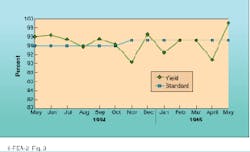CHRISTOPHER ROWAN
Excimer lasers were first conceived of in 1960; they were demonstrated in 1972 and commercialized in 1976. The first commercial excimer laser was produced by Tachisto Inc. (formerly of Needham, MA) and was intended for the research and development market. By today’s standards, early systems had low gas lifetimes (about 5000 pulses per gas fill or a few hours) and low average output power (0.04 W). However, the excimer laser was quickly adopted by researchers because of its characteristic output—the short, intense, UV pulses offered very high peak powers.
Fluorescence-related applications accounted for much of the early interest in excimer lasers, and unit sales soon exceeded hundreds per year. Since then, according to some estimates more than 4000 R&D systems have been sold worldwide, and much of the fundamental development work carried out with them has subsequently generated important industrial applications for excimer lasers. Examples of such applications include deep-UV microlithography for semiconductor manufacturing, wire stripping, annealing amorphous silicon to polysilicon, micromachining, multichip-module via (small hole) fabrication, and ablation of vias for inkjet-printer head nozzles (see Fig. 1).
Ablation of vias for inkjet-printer head nozzles is one of the most recently commercialized production uses of excimer lasers and serves to demonstrate that laser manufacturers have succeeded in adapting what used to be an instrument used solely for research to meet the exacting demands of high-volume production environments.
Inkjet printers
An inkjet printer such as is manufactured by Hewlett-Packard (HP, Palo Alto, CA) prints by squirting ink through a matrix of small funnel-shaped holes, or vias, onto paper. In the printhead, a tiny resistor is aligned directly below each via and ink is allowed to flow into the resistor area; when the resistor is heated, the ink on it essentially boils and forces a tiny droplet of ink out of the aligned orifice or via onto the paper. Until recently, the printhead holes on HP printers were made using electroforming or orifice plating technology, which creates a matrix of vias in a nickel sheet.
The diameters of holes made this way vary from 25 to 100 mm, depending on the plating current and duration. Existing HP inkjet printers, such as the DeskJet 560C, print with a resolution of 300 dots per inch (dpi) using printheads with 50 nozzles for the matrix in each printhead; each nozzle diameter is about 50 mm. The conventional hole-producing process is very expensive; if any single nozzle is defective, or if the nozzle size variation for a given matrix is not within specification, then the entire printhead assembly is unusable. Hence, the typical manufacturing yield of this conventional process is between 70% and 85%.
For HP’s newest generation of inkjet printers—the Desk Jet 800C and Desk Jet 1600C—the company increased the printer resolution to 600 dpi to improve the quality of the printed output. This also created the need for more and smaller vias on the printhead, however, so the new pen assembly for the Desk Jet 1600C consequently uses 300 vias—instead of the 100 vias on earlier printers—with a via diameter of 28 µm at the entrance side of the pen.
As the number of vias per pen increases so does the statistical likelihood of a defect; reducing the via diameter also increases the likelihood of a defect occurring. The relatively low production yields of the conventional hole-producing technology, therefore, prompted HP to evaluate alternatives, with the result that, for the first time, an excimer laser is now used to produce the vias in polyimide for the new 600-dpi printers (see Fig. 2).Another longer-term advantage of excimer-laser ablation is that the laser can drill even smaller vias. And, as resolution requirements for printing increase to greater than 600 dpi, the need for smaller-diameter vias drilled with tighter tolerances also increases. Ultimately, the resolution limit for the holes, R, is defined by
R = l/(2(NA))
where l is the wavelength of light and NA is the numerical aperture of the system. Thus, for a KrF excimer laser operating at 248 nm, and assuming a typical NA of 0.1, the resolution limit is 1.2 µm. Given that the via size currently used in the HP printer is 28 µm, the practical limit for excimer-laser ablation of printhead vias is still a long way off.
Excimer lasers are being routinely used in several very-high-volume manufacturing applications of which printhead manufacturing is just one example; via production in multichip modules is another. As laser manufacturers address the needs of production-oriented applications and design systems specifically for the rigors of manufacturing—as well as addressing ease of use and serviceability—they will systematically eliminate concerns about the laser itself and enable production concerns to evaluate the true cost of making a given part. In so doing, excimer lasers will continue to demonstrate themselves as cost-effective solutions in high-volume environments.
ACKNOWLEDGMENTS
The following individuals provided support in the preparation of this article: Rod Williams, Chien-Hua Chen, and Sarah Ligon, all of Hewlett-Packard.
Christopher Rowan is responsible for industrial laser market development at Cymer Laser Technologies, 16275 Technology Drive, San Diego, CA 92127.


